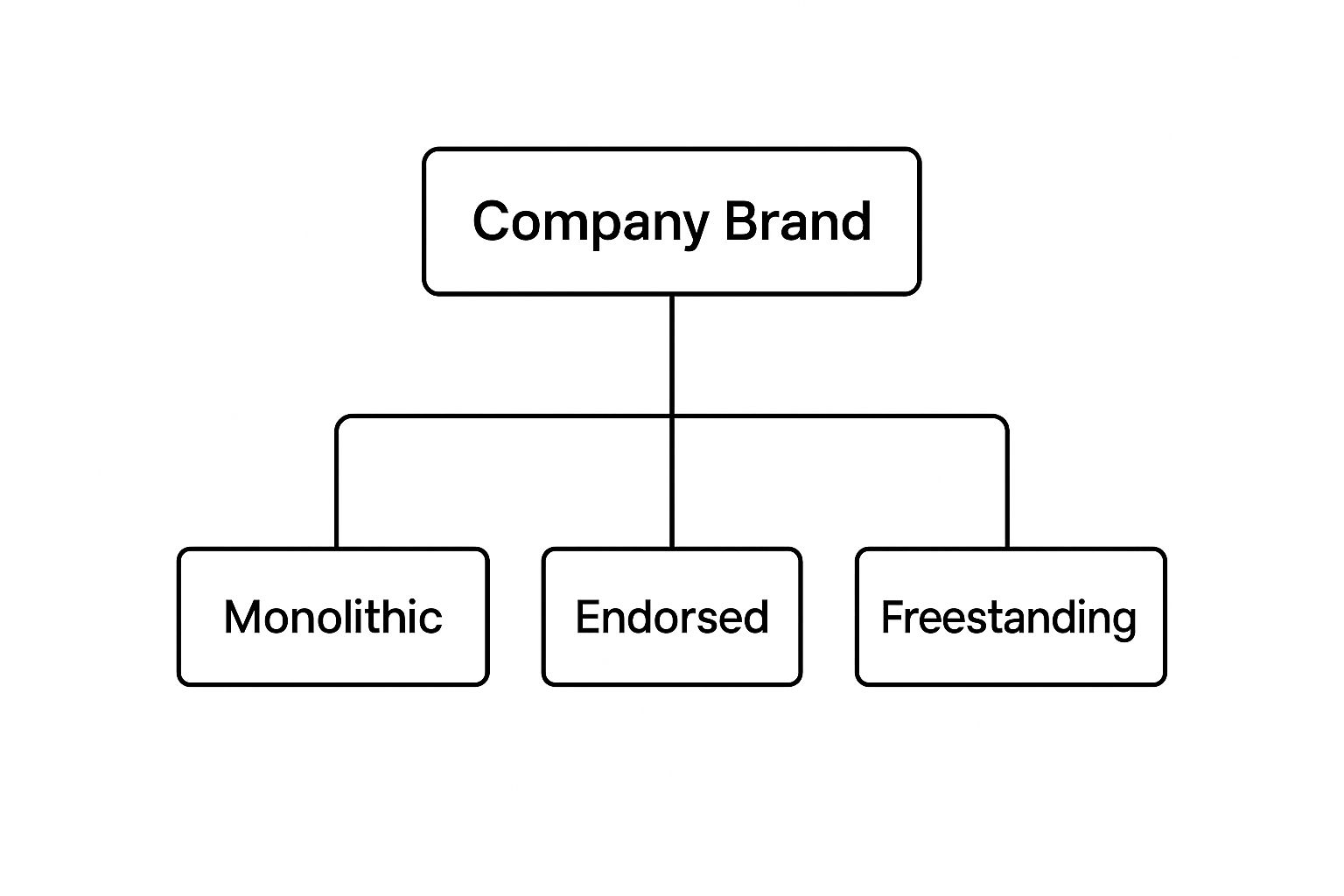Ever wonder how massive companies like Google or Procter & Gamble keep all their products straight? The answer lies in something called brand architecture.
Think of it as a family tree for your company. It’s the strategic blueprint that organizes your brands, sub-brands, and products, showing how everything connects. This structure isn't just for internal use; it’s designed to make your offerings clear and logical to the people who matter most—your customers. A solid architecture prevents confusion and helps you build a much stronger presence in the market.
Unpacking Your Brand's Family Tree

So, what is brand architecture at its core? It's the intentional system that defines how the various brands in your portfolio relate to one another and how they’re presented to the world. It’s far more than a simple marketing choice; it's a core business strategy that directly influences how you grow, where you invest your money, and how you communicate your value.
Even if you only have one product, you're already making brand architecture decisions. Should the product have the same name as the company? Or should it have its own unique identity? Answering that simple question is your first step. As your company and its offerings grow, having a clear structure becomes absolutely critical for maintaining clarity and purpose.
The Strategic Importance of Structure
A well-defined brand architecture provides a clear framework for your entire business, making sure every brand, sub-brand, and product works together as a team. It's what separates a powerful, cohesive brand family from a jumbled mess of unrelated names that just confuses people.
This clarity delivers some serious advantages:
- Prevents Customer Confusion: It makes it easy for customers to understand your offerings and see how your products relate, which simplifies their buying decisions.
- Improves Marketing Efficiency: When brands are logically linked, your marketing efforts can create a "halo effect." Promoting one can boost awareness and credibility for the others.
- Enables Scalable Growth: It gives you a roadmap for launching new products or acquiring other companies without weakening or diluting your main brand's equity.
Brand architecture isn't just an organizational chart for logos. It is a powerful tool that translates business strategy into a market-facing structure, guiding everything from product naming to customer experience.
A Growing Business Imperative
The need for clear brand organization isn't just a fleeting trend—it's becoming a crucial part of doing business. The global market for brand architecture services was valued at around USD 26.90 billion in 2025 and is expected to hit an estimated USD 57.57 billion by 2033, growing at a CAGR of 7.7%. This boom shows just how seriously companies are taking strategic brand management to stay competitive.
To see how brand architecture fits into the bigger picture, check out this excellent guide on a Modern B2B Brand Strategy. It does a great job of showing how a solid structure is the foundation you need to build a powerful and lasting brand.
Alright, so you’ve decided you need a plan for how your brands relate to each other. Smart move. But how do you actually structure it?
Generally, there are three main ways to organize your brand family. Think of them as different playbooks. Each one sets up a different kind of relationship between your main company and the products or services it sells.
Picking the right one isn't about finding the "best" model—there's no such thing. It's about figuring out which approach aligns with your specific business goals, who you're trying to reach, and the story you want to tell.
This diagram lays out the three core models. On one end, you have a single, unified brand. On the other, a collection of totally separate ones. And right in the middle, a mix of both.

Let's break down what each of these looks like in the real world.
The Branded House Model
First up is the Branded House model. You might also hear it called a monolithic architecture. The concept is simple: one master brand is the hero. Everything the company does—every product, every service—operates under that single, powerful name. The parent brand is always front and center.
Google is a perfect example. We don't think of Maps, Docs, and Photos as separate companies; they're all just Google. The same goes for FedEx, which uses its core brand for FedEx Express, FedEx Ground, and FedEx Freight. This creates a really clear and consistent brand experience for customers.
The biggest win here is efficiency. When you market one product, you're indirectly boosting the entire brand family. This builds incredible brand equity and recognition over time. Plus, it makes life easier for customers—if they trust the master brand, that trust naturally extends to any new product you launch.
Of course, there's a catch. This approach puts all your eggs in one basket. If one product gets a bad rap or fails spectacularly, it can damage the reputation of the whole brand.
The House of Brands Model
On the complete opposite side of the spectrum is the House of Brands model. With this strategy, a parent company owns a whole portfolio of individual brands, each with its own unique identity, personality, and place in the market. Most of the time, customers have no idea these distinct brands are all owned by the same entity.
The undisputed champion of this model is Procter & Gamble (P&G). P&G is the silent force behind giants like Tide, Gillette, Pampers, and Crest. The P&G name itself is practically invisible to shoppers. This strategy allows the parent company to dominate entire market categories by creating products tailored to very specific consumer segments.
This model provides amazing flexibility. A crisis hitting one brand is contained and won't poison the well for the others in the portfolio. The downside? It's expensive. Really expensive. Each brand needs its own separate marketing budget, its own strategy, and its own team to build awareness from the ground up.
The Hybrid Model
As you can probably guess, the Hybrid model is a strategic mix of the Branded House and House of Brands approaches. Companies using this playbook have a strong corporate brand, but they also manage sub-brands that have their own identities, often with a clear endorsement from the parent.
Think about Marriott. The Marriott name acts as a seal of approval, signaling quality and trust. But under that umbrella, they operate distinct hotel brands like The Ritz-Carlton, Westin, and Sheraton, each designed to attract a different type of traveler. The Coca-Cola Company does something similar. Coke, Diet Coke, and Coke Zero are clearly part of the mothership, but the company also owns standalone brands like Dasani and Vitaminwater.
This balanced approach offers the best of both worlds:
- You can use the master brand's reputation to give newer or smaller sub-brands a leg up.
- It gives you the freedom to acquire or create new brands that can stand on their own two feet.
- You can run targeted marketing campaigns while still maintaining a link to the corporate identity.
While the hybrid model can be more complex to manage, its versatility is a huge advantage. It gives companies a flexible framework to grow and adapt as the market changes.
Brand Architecture Models at a Glance
To make it even clearer, let's compare these three models side-by-side. This table breaks down their core strategies, key benefits, and the situations where they tend to work best.
Seeing them laid out like this really helps highlight the fundamental differences in philosophy. Your choice will ultimately shape not just your marketing, but how your entire organization is perceived.
Strategic Benefits of a Well-Planned Architecture

Let's move past the theory. The real power of a solid brand architecture shows up in tangible business results. This isn't just about drawing a neat org chart for your brands; it's about creating a strategic asset that delivers real advantages, turning a messy portfolio into a focused engine for growth. A clear structure gives you direction, and that impacts everything from how customers see you to your bottom line.
Think about it: when your brand family is well-organized, you get rid of the confusion that sends potential customers running. People crave clarity. A logical brand system makes it easy for them to understand what you do and why they should care. That clarity is the first, most crucial step toward building trust and making a sale.
Creating Clarity and Boosting Sales
The biggest win from a well-planned architecture is crystal-clear market positioning. When customers can easily see how your different brands and products connect, they aren't left scratching their heads. Instead, they quickly find the right solution for their needs. This simple clarity smooths out the customer journey and can dramatically cut down on friction in your sales process.
A logical structure also builds natural bridges between your products, opening the door to valuable cross-selling opportunities. For instance, a customer who trusts your main brand for one product is far more likely to try another offering under that same familiar umbrella. This interconnectedness helps you grow revenue from the customers you already have.
A strong brand architecture ensures that the whole is greater than the sum of its parts. Each brand, instead of competing for resources and attention, contributes to a shared pool of equity, strengthening the entire portfolio.
This shared strength is built on a foundation of consistency. Every time a customer interacts with any part of your brand ecosystem, it should reinforce the core promises you’ve made. To dig deeper into this critical element, check out our guide on what is a brand promise and how to build one.
Optimizing Your Marketing Spend
One of the most powerful advantages is how much more efficient your marketing becomes. Instead of funding dozens of separate, competing campaigns, a smart architecture lets you pool your brand equity. A single campaign for the parent brand can create a "halo effect" that lifts all the associated sub-brands, making your marketing budget work much, much harder.
A well-structured brand architecture is also a game-changer for building market presence and trust, which is the bedrock of digital visibility. For a closer look at improving your online footprint, you might want to explore these effective SEO strategies to build brand authority.
Ultimately, a coherent structure pulls off two critical goals at once:
- Strengthens Parent Brand Value: Every successful sub-brand or product adds to the credibility and reputation of the main corporate brand.
- Boosts Sub-Brand Success: Sub-brands get a leg up with instant credibility and trust just by being associated with an established parent brand.
This symbiotic relationship transforms a jumbled collection of assets into a powerful and resilient force in the market. It gets every part of your business pulling in the same direction, creating a unified brand that customers find easier to understand, trust, and ultimately, choose.
How to Build Your Brand Architecture Step by Step
Building or fine-tuning your brand architecture isn't just an abstract exercise; it's a strategic project that lays a concrete foundation for growth. It can feel like a massive undertaking, but when you break it down into clear, manageable steps, it becomes much less intimidating. Think of it as drawing up the blueprint before you start building the house.
This process is far more than a simple marketing task. It’s a fundamental business decision that brings your products, teams, and long-term goals into alignment. Companies are investing heavily in getting this right. In fact, the global branding agencies market, often brought in to guide this very process, was valued at $5.2 billion in 2023 and is expected to hit $8.7 billion by 2032. That's a serious testament to how critical this work is. You can dig deeper into the growth drivers in the branding agency market.
Here’s a practical, four-phase approach to help you build a powerful and coherent architecture for your business.
Phase 1: Conduct a Brand Audit
Before you can chart a course for the future, you have to know exactly where you are right now. A thorough brand audit is your starting point. This means gathering up all your existing brand assets and taking a hard, honest look at how they’re perceived, both inside and outside your company.
The goal here is to get a clear picture of your current brand ecosystem. This audit will shine a light on your strengths, weaknesses, inconsistencies, and maybe even some opportunities you didn’t realize were there.
During your audit, ask these key questions:
- Inventory: What are all the brands, sub-brands, and product names we currently have in the market?
- Perception: Do our customers and employees actually understand how these brands relate to one another? Is there any confusion?
- Consistency: Do our brands present a unified look, feel, and message everywhere they appear?
- Equity: Which of our brands are the strongest, with the best recognition and reputation? Which ones are lagging behind?
Phase 2: Define Your Core Strategy
With the insights from your audit in hand, you’re ready to make an informed decision. Which brand architecture model—Branded House, House of Brands, or Hybrid—is the right fit for your long-term vision? This isn't about picking the "best" model on paper, but the one that truly clicks with your business strategy, target audience, and future growth plans.
For example, if your strategy is to dominate a single market with one powerful, unified message, a Branded House is likely your best bet. On the flip side, if you're serving completely different customer groups with unique needs, a House of Brands gives you the flexibility to connect with each one authentically.
The right architecture model should feel like a natural extension of your business strategy. It should clarify your path forward, not complicate it. Choose the structure that will best support your company's vision for the next five to ten years.
Phase 3: Create Your Visual and Verbal System
Once you’ve settled on a model, it’s time to bring it to life. This phase is all about building the system—the clear, consistent rules for how your brands will look and sound. This covers everything from logos, color palettes, and typography to naming conventions and the tone of voice used in your messaging.
Think of this system as the practical toolkit your team will use every single day. It ensures that whether someone is designing a social media post or preparing a new product launch, the result feels cohesive and unmistakably yours. A comprehensive set of rules is essential, and you can learn more by exploring what is in a style guide with our complete brand blueprint.
Phase 4: Plan Your Rollout
Finally, even the most brilliant brand architecture is useless if it’s not implemented well. A carefully planned rollout is absolutely critical for managing the transition for everyone involved—from your employees and partners to your loyal customers.
Your plan should map out a clear timeline, assign specific responsibilities, and detail exactly how the changes will be communicated. A well-managed rollout minimizes confusion, builds genuine excitement internally, and ensures everyone understands the "why" behind the shift. Done right, this turns your entire team into your most enthusiastic brand ambassadors.
Real-World Examples of Winning Architectures

Theory is one thing, but seeing brand architecture in action is where it all clicks. The world's most recognizable companies didn't get there by accident; they used these frameworks to build powerful, memorable brand families. Looking at their playbooks shows you just how much the right structure can pay off in the long run.
Let's break down how three giants have mastered their brand portfolios. Their stories offer some great lessons, no matter how big or small your company is. By studying their choices, you can get a better feel for which model might work for you. For an even deeper dive, you can explore more top brand architecture examples for 2025.
Apple: The Quintessential Branded House
When you think of a Branded House, you think of Apple. It’s the textbook case. Every single product—the iPhone, iPad, MacBook, and Apple Watch—is clearly and proudly an Apple product. The master brand is the hero, and every product simply adds to its legend.
This strategy creates an incredibly cohesive customer experience. The trust someone has in their iPhone immediately extends to a new product like the Vision Pro, without a second thought. Apple’s marketing machine is always focused on buffing the shine on the main Apple logo, which in turn elevates everything else they sell. It's a masterclass in building and using brand equity.
Unilever: A Masterful House of Brands
On the complete opposite end of the spectrum, you have Unilever, a classic House of Brands. Most shoppers have no clue that Dove, Axe, Ben & Jerry's, and Lipton all live under the same corporate roof. Each brand stands on its own, with a unique identity, target audience, and marketing strategy.
This approach gives Unilever some serious advantages:
- It can dominate multiple market segments without its brands competing against each other or causing confusion.
- The portfolio is insulated from risk. If one brand hits a rough patch, the others remain untouched.
- They can create hyper-focused products that connect deeply with very specific groups of consumers.
The Unilever name stays quietly in the background, letting each of its brands take the spotlight. It's a strategy that requires a massive investment to build each brand from scratch, but the market control it gives them is undeniable.
The strategic choice of architecture has a measurable impact on a company's market value. A clear system can be a massive competitive advantage.
For example, look at the difference in brand evolution between two tech competitors. By focusing on a clear brand architecture, Huawei's brand value grew to an estimated $29–65 billion by 2020. Meanwhile, its rival ZTE, with a less defined structure, reached a brand value of only $1.9 billion in the same period. You can discover more insights about this impact of brand structure on value at Smashbrand.com.
Microsoft: The Flexible Hybrid
Microsoft perfectly illustrates the power of a Hybrid model. The main Microsoft brand acts as a foundation of trust and quality, especially for its business-focused products like Microsoft 365 and Azure. At the same time, the company allows some of its other brands to build their own powerful, distinct identities.
Xbox is the best example. Everyone knows it’s a Microsoft product, but it operates in its own universe with a unique culture, audience, and marketing voice. The Surface brand has also carved out its own premium identity, separate from the more utilitarian feel of Windows. This hybrid strategy gives Microsoft the flexibility to play in very different sandboxes while still benefiting from the strength of its core name.
Common Questions About Brand Architecture
Even after you get the hang of the models and benefits, some practical questions always pop up when you start applying these ideas to your own company. It's one thing to know the theory, but putting it into practice is a whole different ballgame. Let's clear up some of the most common sticking points that come up.
Think of this section as a quick reference to help you talk confidently about brand architecture with your team and make smarter decisions.
How Often Should We Review Our Brand Architecture?
As a general guideline, a thorough review every 3-5 years is a good idea. This timeframe is usually enough to account for natural shifts in the market and how your business has evolved.
That said, some events demand an immediate look under the hood. Any major business change should trigger a review to make sure your structure still makes sense and supports your new goals. These events include:
- A significant merger or acquisition
- A major pivot in your company's strategy
- Expanding into entirely new markets or product lines
- A complete company rebrand
Skipping a review during these moments is a classic mistake. It can quickly lead to a diluted brand and confused customers, which is a mess you don't want to have to clean up later.
What Is the Difference Between Brand Architecture and Brand Portfolio?
This is a common question, but the distinction is actually pretty straightforward once you see it.
Think of it this way: your brand portfolio is the "what," and your brand architecture is the "how."
Your brand portfolio is simply the full collection of brands, sub-brands, and products your company owns. It’s the list of players on your team. For instance, Procter & Gamble’s portfolio includes names like Tide, Gillette, and Pampers.
The brand architecture is the game plan that organizes all those players. It defines how they relate to each other, their specific roles, and their hierarchy. It’s the system that ensures they all work together to tell one clear, powerful story.
Does a Small Business Need Brand Architecture?
Yes, absolutely. In fact, thinking about your brand architecture early on is one of the smartest moves a small business can make.
Even if you just have one company name and one product, you're already making architecture decisions. Do you call the product by the company name? Or give it a name of its own? That’s your very first architectural choice.
Nailing this down from the start builds a strong, scalable foundation for future growth. It makes sure that every new service or product you add strengthens your main brand instead of creating confusion. A simple, clear architecture prevents the kind of brand chaos that can easily hold a growing business back.
Ready to build a powerful brand identity that sets you up for success? At Softriver, we specialize in creating custom logos and comprehensive brand ecosystems that bring your vision to life. Our expert designers craft timeless, market-aligned identities that convey professionalism and build immediate trust. Get your custom brand identity started today.







